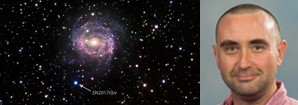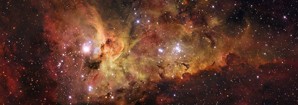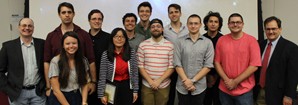Spotlight

New Faculty Member Dave Sand Tries to Find Supernovae As They Explode
Due to their roughly similar brightness, type Ia supernovae are vital for measuring distances and understanding dark energy in the Universe. Despite their utility, it is still not clear by what mechanism the white dwarf is pushed over the edge to explode -- it could be the inspiral of two white dwarfs losing gravitational energy, or a relatively normal star feeding the white dwarf until it becomes unstable. Observations by Dr. Dave Sand and his team have recently caught a very young type Ia supernova in the act of exploding, and the light curve reveals a 'blue bump'-- a long predicted, but never before seen, signature of the second scenario. This bump in the light curve is expected if the supernova ejecta crashes into a normal companion star, causing the envelop of the star to become shock heated and to emit some extra radiation that manifests itself as the extra 'bump' in the supernova light curve. Sand and his team have designed a supernova search exactly for this task, and these are the initial results of the program. You can find the UA press release HERE.
Dr. Sand was a Chandra Fellow postdoctoral scholar at Steward until about seven years ago, and after a second postdoctoral fellowship at Harvard & LCOGT, followed by a faculty position at Texas Tech, rejoined us as a faculty member on August 14.

Community Science Scholars and OSSI
The UA College of Science has announced a new program for members of the Tucson community. You can take classes at a reduced rate! You can find out the procedure for enrolling HERE and the courses offered this semester HERE. Astronomy courses offered are: Astr 170B1 with Dr. Don McCarthy, MWF at 9:00-9:50am; Astr 203 with Dr. Thomas Fleming, TTh 2:00-3:15; and Astr 333 with Dr. Richard Poss, MWF 11:00-11:50am. An Arizona Daily Star article can be found HERE.
Please note that there's a second offer by the UA, called Osher Lifelong Learning Institute, meant expressly for people over 50 years of age. the link is HERE.
Image courtesy of The College of Science

A Sharp Look at the Wind from a Dying Star
Eta Carinae is perhaps the most interesting star in the Milky Way. It is very unstable and has ejected lots of material into space in the last few hundred years. Understanding how Eta Carinae drives its powerful wind can provide clues to the late evolutionary stages of very massive stars. To test whether our ideas of its unique stellar wind are correct, Steward astronomers used the 6.5 meter Clay Telescope together with Steward's Magellan adaptive optics (MagAO) system to image Eta Carinae in two wavelengths at some of the highest angular resolutions ever achieved (FWHM=0.025 arcseconds, which is the angular size of dime seen ~ 100 miles away). One image is at H-alpha emission line (656 nanometer) probing the wind itself, and the other is the continuum (643 nanometer) probing the surface of the star. Comparing the sizes of Eta Carinae in both images can tell us about the extent of the wind. The results suggest that most of the H-alpha emission is emitted in regions about 30 AU (~0.012 arcsec) from the star (I AU is the separation between the Sun and the Earth), in good agreement with stellar -wind model proposed earlier.
More can be found on AAS NOVA HERE.

Nine Astronomy Majors and Sixteen Astronomy Minors Graduated from the University of Arizona in May
We celebrate University of Arizona Commencement this week by congratulating and saying goodbye to nine astronomy majors and sixteen astronomy minors. The majors are Chris Bullivant, Jiani Ding, Morgan Ryleigh Fitzpatrick, Kirk Hendricks, Ricardo Maciel, David Setton, Zachary Watson, Anthony West, and Ian Winner. Minors are Kade Bowers, Alyssa Evans, Miles Fujimoto, Nathaniel Goss, Lance Guzman, Garrison Joachim, Keith Kristofitz, Nicolas Marquez, Joseph Martin, Lauren Palma, Joshua Ritter, Mary Semon, Sai Akshay Sreedhar, Shannon Sylvester, John Thaxton IV, and Stephanie Williams.
The photo shows, from left to right: Professor Yancy Shirley, Tony West, Shannon Sylvester, Chris Bullivant, Jiani Ding, David Setton, Nathaniel Goss, Ian Winner, Zach Watson, Kirk Hendricks, Ricky Maciel, Joseph Martin, and Head, Department of Astronomy & Director, Steward Observatory, Dr. Buell Jannuzi.

Podcast of Brian Schmidt's Public Aaronson Symposium Talk
We are pleased to announce that the Podcast of Nobel Laureate Brian Schmidt's Public Aaronson Symposium talk is now available. The talk is 67 minutes long, entitled "The State of the Universe 2017."
Brian was an undergrad at UA in the late 80s, and was our Aaronson Lecturer in 2005. He was one of the three Nobel Laureates in Physics in 2011 "for the discovery of accelerating expansion of the Universe through observations of distant supernovae."
Pages

For Public
Public events include our Monday Night Lecture Series, world-reknowned Astronomy Camp and Mt Lemmon Sky Center.

For Students
A good place to start if you want to become an undergrad major or grad student, or need to find our schedule of classes.

For Scientists
Find telescopes and instruments, telescope time applications, staff and mountain contacts, and faculty and staff scientific interests.




